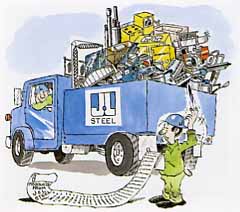


If you were a chemist, you could analyze a chunk of steel in your laboratory and discover that it consists of: lots of iron; a bit of carbon; small amounts of other chemical elements including manganese, silicon, copper, phosphorus, aluminum, molybdenum and others.
By varying the amounts of carbon and other elements that are combined with the iron, many different kinds of steel, each with its own properties, can be made. This is why steel is such a versatile material and why it can be custom tailored for specific applications.
Carbon steel is ordinary steel. It has an extraordinary range of uses, everything from car bodies to bed springs. Most of the steel we make is carbon steel.
Alloy steel is used in those applications that require extreme hardness, strength or toughness, for example, engine parts and car transmission gears. Alloy steels contain carefully controlled amounts of the other elements we mentioned above, particularly molybdenum, chromium and nickel.
Stainless steel is a special kind of alloy steel that contains a large amount of chromium and nickel. It is far more resistant to staining and corrosion (rusting) than carbon or alloy steels.
Stainless steels are often used to manufacture products that will come into contact with food and chemicals or will be subjected to high temperatures.
As you'll soon see, the making of steel is a two-step process. First, iron is made in a blast furnace. Second, the impurities in the iron are removed and certain elements are added to produce a metal that has a specific mix of ingredients and physical properties. This is steel.
In many ways, a steel mill islike a huge kitchen, where the ingredients are measured in hundreds of tons rather than by cups or ounces. A fundamental challenge of steel making is to make each batch or heat of steel according to a specific recipe, the recipe that yields the properties called for by the customer.